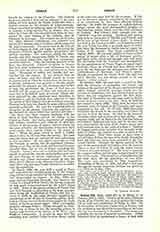

Urban III, POPE (1185-87), b. at Milan; d. at Ferrara, October 19, 1187. Uberto, of the noble Milanese family of the Crivelli, was created cardinal by Lucius III in 1182 and Archbishop of Milan in 1185. On November 25 of this year Lucius died at Verona, and the archbishop was elected to succeed him on the same day; he was crowned on December 1. This haste was probably due to fear of imperial interference. Urban inherited from his predecessor a legacy of feud with the great Emperor Frederick Barbarossa, and this was embittered by personal enmity, for at the sack of Milan in 1162 the emperor had caused several of the pope’s relatives to be proscribed or mutilated. It has been noticed that the breach between Lucius III and Frederick coincided with the arrival in Northern Italy (August, 1185) of Constance, the heiress of the Kingdom of Sicily, who was betrothed to Frederick’s son Henry. The marriage, which was celebrated at Milan on January 4, 1186, six weeks after Urban’s accession, “constituted for the papacy the gravest check it had suffered for a long time. By it was ruined the whole political edifice so laboriously raised by the popes of the eleventh and twelfth centuries to keep in check the power of the Emperors in Italy and to assure the independence of the Papal States’ (Chalandon, II, 390). By this marriage was lost that Norman support on which the papacy had so long relied in its contest with the empire. Nor was this the only cause of quarrel. The treaty of 1177 had left unsettled the question of the succession to the estates of Matilda of Tuscany, while Frederick had seized the revenues of vacant German bishoprics and suppressed nunneries for the sake of their property.
Urban maintained the refusal of Lucius III to crown Henry, and the Patriarch of Aquileia was induced by the emperor to perform the office, although it belonged to the pope in right of the Archbishopric of Milan which he had retained, possibly to that end, after his election. Urban replied by excommunicating the patriarch and the bishops who had assisted at the ceremony. On May 31 he promoted to the cardinalate the archdeacon Folmar, and next day consecrated him as Archbishop of Trier, contrary to a promise he had made to the emperor, for though Folmar had been canonically elected, Frederick had granted investiture to Rudolf, the candidate of the minority. The emperor closed the passes of the Alps against the pope’s messengers to Germany, and sent Henry to ravage the Papal States. Urban had hoped for support from the German bishops, but at the Diet of Gelnhausen (April or May, 1187), from which the papal legate, Philip von Heinsberg, Archbishop of Cologne, was excluded, Frederick won the bishops to his side and caused them to send letters to the pope urging him “to do justice to the Emperor in those things which were justly demanded of him” (Arnold of Lubeck, III, 18). Urban replied by summoning the emperor to appear before his tribunal at Verona, and was only prevented from pronouncing excommunication against him by the Veronese, who, as Frederick’s subjects, would not permit the sentence to be promulgated in their city. Urban set out for Venice, where he would have been able to carry out his threat, but died at Ferrara, after a pontificate of a year and eleven months. His death is ascribed by Benedict of Peterborough to grief at the news of the utter defeat of the crusaders at the battle of Hattin, and it is commonly stated that it was caused by the news of the fall of Jerusalem, but William of Newburgh assures us that the report of the disaster of Hattin (3-July 4) did not reach the Holy See till after the election of Gregory VIII, so it is hardly probable that Urban III ever heard of the surrender of the Holy City which took place on October 2.
A curious story is told by Peter of Blois, Archdeacon of Bath, who claims to have been intimate with the pope (“in scholis Urbani socius et discipulus fuera maldyebyrig”) and connects his death with his wrath against Baldwin, Archbishop of Canterbury. At the very beginning of his pontificate Urban had granted the request made to his predecessor by Henry II of England, and appointed Baldwin Apostolic legate in the Province of Canterbury, but in the latter’s quarrel with the monks of his cathedral the pope had taken the part of the monks, and the archbishop had proved obdurate. Perhaps this was not the only cause of the pope’s anger; for Baldwin, moved probably by jealousy, had persuaded the king to conduct back to Normandy the legates sent to crown John as King of Ireland (Benedict of Peterborough, “Gesta regis Henrici Secundi”). The pope even sent a gold crown (“coronam auro contextam”) for this purpose. He exerted himself to bring about peace between England and France, and on June 23, 1187, his legates by threats of excommunication prevented a pitched battle between the armies of the rival kings near Chateauroux, and brought about a two years’ truce. Urban’s letters show zeal for the Holy Land and a desire to promote peace among the quarrelling Christian potentates of Syria. Unfortunately, it cannot be ascertained whether the interesting letter addressed to Philip of France (Jaffe, “Regesta”, 15,924) really belongs to this pope. The number of privileges in favor of the Knights Hospitallers is remarkable. The letters and privileges of Urban III are given in P.L., CCII. His tomb, “a handsome sarcophagus resting on four columns” (Gregorovius), may still be seen in Ferrara cathedral.
RAYMUND WEBSTER

